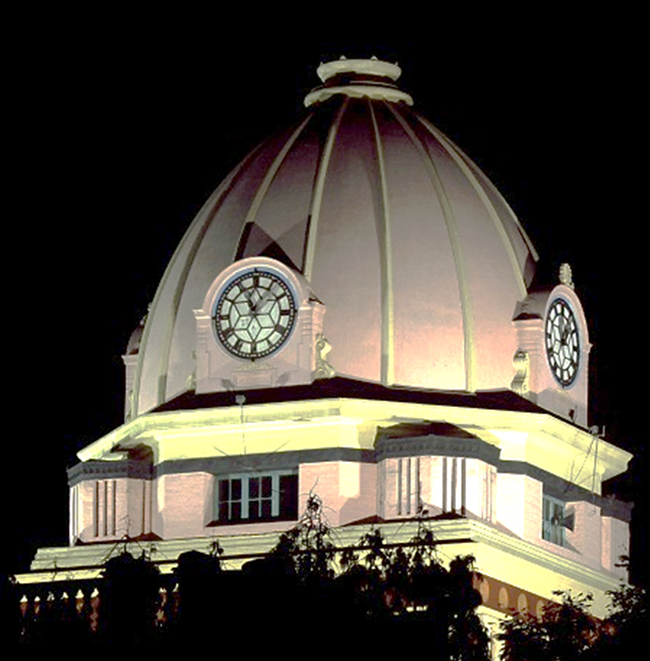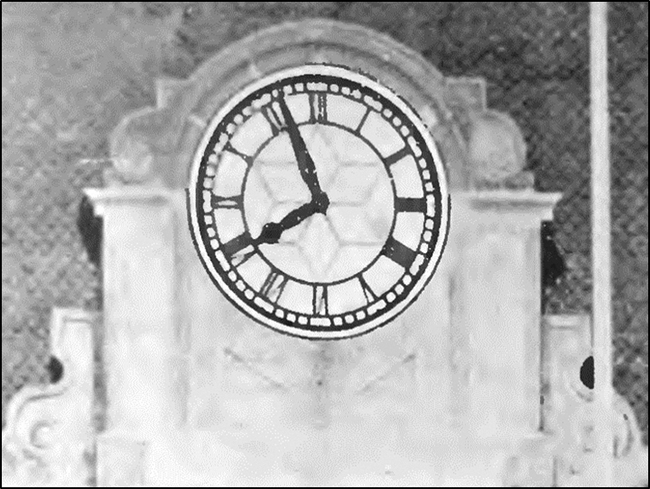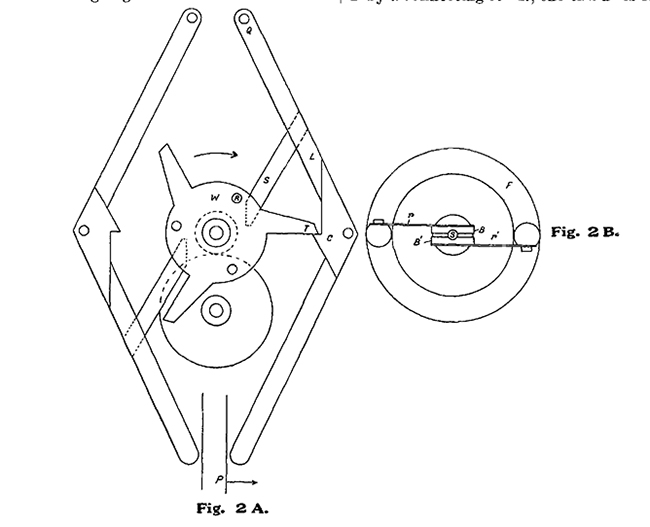Registered with the Registrar of Newspapers for India under R.N.I 53640/91
Vol. XXXIII No. 19, January 16-31, 2024
H(arihara) P(arames) Waran of the Madras Presidency College and the clock he made in 1930
-- by Anantanarayanan Raman (anant@raman.id.au)
The four-face clock on the Presidency College main building is a majestic attraction. Only a few in Madras would know that this clock — has a name: the ‘Fyson Clock’. Mr. Muthiah in his Madras Miscellany column (https://www.the-hindu.com/news/cities/chennai/chen-columns/have-they-got-them-right/article 3436028. ece, accessed 4 January 2024) speaks of the clock and Fyson, whom it celebrates. ‘When this clock was made’ and ‘by whom’ form the rest of this story. Because Muthiah has already written about Fyson and a Wikipedia site exists on him, I am not elaborating any more.
* * *

Fig. 1. The Fyson clock. (Source: https://thewire.in/books/book-review-empire-building-rosie-llewellyn-jones, accessed 27 December 2023).
In the chapter ‘Presidency College, Madras’ (pages 1–8) in the History of Higher Education in South India – II, University of Madras, 1857–1957, Affiliated Institutions, edited by K. Balasubrahmanya Aiyar, K.K. Pillay, et al. and published by the University of Madras, Madras (1957, p. 398), a paragraph occurs in p. 6 (reproduced below), which explains the naming of the clock after Fyson by its creator H.P. Waran.

H.P. Waran was a highly qualified physicist and an academic of the Presidency College, Madras (PCM). He held the Fellowship of the Institute of Physics, London. In 1934, Waran published a detailed and a fascinating article on the tower clock constructed by him. Details of that article are ‘Waran, H.P., 1934, An automatic electric tower clock made in India, Current Science (Bangalore), volume 3, pages 395–400’.

Fig. 2. One face. (Source: Waran, 1934).
H.P. Waran was the shortened form of ‘Harihara Parameswaran’ (1897–1953). A group photograph of the academic staff of the Madras Presidency College made in 1925 (p. 107, the Centenary Commemoration Book, Presidency College, Madras, 1940; https://dn790009.ca.archive.org/0/items/dli.csl. 6252/6252.pdf, accessed 3 January 2023), which includes him has been reproduced above (Fig. 3).

Fig. 3. Academic staff of PCM, 1925. H(erbert) S(pencer) Duncan (Principal) seated 9th from the left, front row. H. P. Waran is seated 4th from the left, front row (circled). Source: Centenary Commemoration Book (1840–1940), Presidency College, Madras.
I managed to get hold of two science articles written by Waran: (1) ‘A new form of interferometer’, Proceedings of the Royal Society of London, 1922 (100: 419–423). (2) ‘An interferometer method of determining the phase difference resulting from metallic reflexion’, Philosophical Magazine, London (6: 471–477). In both articles he identifies himself as ‘H.P. Waran, M.A. (Madras), Government-of-India Scholar of the University of Madras’. The supplied detail is unhelpful, especially 90 years later, to decide whether he published these articles in British journals while he was in Madras or in London. At the ends of both articles, he acknowledges Rhishard Llewellyn Jones (1865–1932), professor of physics, PCM, for helping him in executing and publishing those works. Interferometry is a measurement method using the interference of light, radio, and/or sound waves. It is useful in measuring tiny variations that occur on the surfaces of microscopic organisms to ginormous variations in gas and dust in the distant Universe – the latter usually done using radio interferometry. Jagadish- Chandra Bhattacharyya and Alladi Vagiswari of the Indian Institute of Astrophysics, Bangalore, in their article Astronomy in India in the 20th century (Indian Journal of History of Science, 1985, 20, 403–435, say,
‘H.P. Waran of Madras made the largest aperture paraboloid before 1947. He used a grinding machine fabricated by himself for the purpose. The mirror of 24-inch aperture was the primary of a reflecting telescope that could not be completed due to paucity of funds.’
Two things become clear: (1) he was interested in Astronomy. (2) He made the grinding machine to grind the mirror required for the telescope. Incidentally, Waran’s son Parameswaran Hariharan was an equally versatile physicist, who achieved profoundly. Hariharan designed various presently used interferometers and pioneered in developing holographic interferometry. All of these illustrate that H. P. Waran’s brilliance as a creator, innovator, further to being a rigorous scientist. Creation, innovation, and high-quality science are collectively and powerfully reflected in the narrative below, that refers to the tower clock he built.
The History of Higher Education in South India indicates Waran named the clock after Fyson, when PCM celebrated its centenary and when Harold Charles Papworth was the Principal (1934–1942). For the following narrative I have relied on Waran’s 1934 article. The clock was ready in 1930; a new cupola was built to accommodate it atop the main building of PCM and positioned on it in 1931 and not in 1932–1933 as in the History of Higher Education in South India, University of Madras. Waran clarifies that in p. 395:
‘One such (sic. ‘electric’) clock of novel design, constructed at the Presidency College in 1930, has already established its reputation by its excellent performance for the last three years’.
Waran should have retired from service sometime between 1935 and 1940 (details unclear). However, the Centenary celebration committee may have thought of a name for the clock and approached Waran for permission; alternatively, Waran could have named it the Fyson clock. This aspect stands unclarified.
Waran explains in p. 395:
‘The clock has an illuminated dial six feet (1.83 m) in diameter the frame being of cast iron one inch (2.54 cm) thick with a central star shaped webbing to stand the heavy wind thrust in the exposed situation right opposite to the sea. The panels are filled with plate glass ¼ inch (0.64 cm) thick frosted and painted inside with white enamel to get a translucent finish. The hands are of ribbed aluminium casting ⅛ inch (0.32 cm) in thickness and four inches (10.16 cm) wide each weighing about 2 lb (0.91 kg).
Waran supplements these details with high-quality line sketches (Figs. 2A and 4 in the original text) that match the quality of engineering artwork, while explaining the electrical circuit he had used in this clock.


The text in his article is appropriate for professional readership. Since MM is read by people of varied backgrounds and interests, I have attempted to offer a simple explanation, highlighting the innovations. One fascinating novelty is the isochronism (the orderly sequence; iso – equal, identical; chronism – that pertains to time) of the pendulum, which is ensured by the influence of a gravity-lever escapement (a mechanism in a clock that rhythmically checks and releases the train of wheelwork and transmits regular power drive from the spring or the weight to either the balance wheel or the pendulum), that is brilliantly clarified in Fig. 2A. To forge the pendulum rod, he chose the ‘iron–nickel’ alloy (‘invar’ metal, FeNi36), which is brilliant and thoughtful because of its uniquely low coefficient of thermal expansion and the possible influences of temperature variations in the atmosphere during sizzling summers and cool monsoons. He introduced an inertia wheel in the complex train of wheelwork, to mitigate the noise arising when wheels wind and re-wind during clock operation. The drive of this mechanism is run by a weight of 100 lb (c. 45 kg) hung on an ‘endless chain’ (a physical term referring to a long chain of metal beads) that goes around a sprocket wheel locked on to a small-hand shaft that completes a circle hourly. Waran indicates that he used ‘power-maintenance’ by slightly modifying Huygens chain drive (Christiaan Huygens, 1629–1695, Dutch mathematician, physicist, engineer, inventor; however what modification did Waran do is not clear), which maintained power when the clock wound up automatically; moreover, this arrangement facilitated an easy and convenient drop of weight-carrying chains in the newly constructed building tower, which included only a 4 feet (1.22 m) space in terms of height. Waran clarifies that his clock design fitted snugly in the available tower space. The automatic winding system was mechanized by using a falling driving weight on a projecting arm, which after an hour of fall, was to rest on a pivoted lever. The end of the pivoted lever connected to a winding motor using a mercury switch. Mercury switch is an electrical switch that utilized a drop of mercury connecting metal electrodes to close the circuit. Choice of a mercury switch by Waran in this clock as a device to break and connect circuit – patented in 1922 by Louis A.M. Phelan, an American businessperson and inventor – is innovative, thoughtful, and remarkable, and this switch served his purpose intently and purposefully.
In page 399, Waran elaborates on the gear systems and the lubricating oil bath used in this clockwork. He also explains the automatic switching on of lighting of dial-faces from 6 to 10 p.m. every day and indicates that the 4 h lighting of the clock faces was to reduce the College’s power bill. In this regard he speaks of the necessary changes in the timing of lighting with seasons, although in contexts such as Madras, this is no big deal. However, he clarifies that the rod carrying the switch lever was changing its length with changes in temperature, which subtly altered the time as well. In other words, he explains that in summer, with the prevalent higher mean temperature, the switch lever rod elongated just adequate to modify the lighting up time, and the converse occurring in not-so-hot months.
The foremost element is that this indigenously constructed clock had nearly saved 75% in terms of overall expense from what it may have cost otherwise, had it been procured from a standard-clock manufacturer. In p. 399, closing his article, he says:
‘Every such clock even well designed and executed with every care must have incorporated in it many safety features if trouble is not to be experienced sooner or later’,
which speaks of his sense of care and caution, while taking pride of his creation. In this context he goes to explain how this electric clock will operate during and after spells of outages, with certain reserve of power stored in the works. Additionally he saw to it that an automatic-fire alarm was set up, when the temperature in the tower housing the clock would rise above 50oC. He concludes this article saying,
‘Provision is also made for the clock to switch on automatically the electric bells by which the class periods are signalled in the college.’
He does not clarify details in his 1934 article but says that they will be clarified in the next article.
* * *
This is a brief narrative of the scientific and technological heroism of an Indian academic of Madras in the early decades of the 20th Century. There are clocks, tower clocks, and more tower clocks (with apologies to Pat Hutchins [Patricia Evelyn Hutchins, 1942–2017], British Children’s Writer). Madras can boast of several tower clocks, some old and some recent. Yet, the one atop the main building of PCM has a great story to tell us and this wonderfully ticking clock, even today, should constantly remind us of Harihara Parames Waran, who passionately constructed this monster on the Marina and Philip Furley Fyson for whom this monster is ticking!
* * *
Heartfelt thanks are relayed here to Professor S.K. Satheesh (Chief Editor, Current Science, Bangalore) and M.S. Venugopal (Executive Secretary, Current Science Association, Bangalore and Publisher, Current Science, Bangalore) for granting permission to write on H.P. Waran’s clock using his article published in Current Science in 1934 and also use one of the illustrations from it in the present article. I am grateful to Professor P.S. Ramanujam, Technical University of Denmark, who reviewed the pre-final draft.

